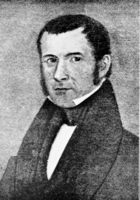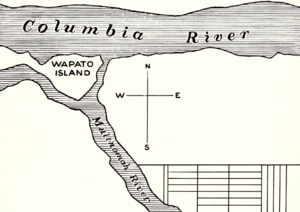Hall J. Kelley facts for kids
Quick facts for kids
Hall J. Kelley
|
|
|---|---|
 |
|
| Born | February 24, 1790 |
| Died | January 17, 1874 (aged 83) |
| Occupation | writer |
Hall Jackson Kelley (born February 24, 1790 – died January 20, 1874) was an American writer and explorer. He is famous for strongly encouraging the United States to settle the Oregon Country in the 1820s and 1830s. Kelley was born in New Hampshire. He worked as a school teacher in Maine and Massachusetts. He lived in Massachusetts for a long time after studying at Harvard College.
In 1834, Kelley led a trip to the Oregon Country. He became very sick while there. The leader of the Hudson's Bay Company at Fort Vancouver made him leave. After returning to Massachusetts, Kelley kept writing about the Oregon area. He wanted more Americans to move there. He also sent his ideas to the U.S. Congress. In 1868, he published a book about the region. By then, thousands of people had already traveled the Oregon Trail. Kelley Point Park in Portland, Oregon, is named after him. He had suggested that people settle where the Willamette and Columbia rivers meet.
Early Life and Education
Hall Kelley was born in Northwood, New Hampshire, on February 24, 1790. He started teaching school when he was just 16 years old in Hallowell, Maine.
He went to Middlebury College in Vermont and graduated in 1814. Then, he graduated from Harvard College in 1820. Kelley also worked as a school principal in Boston from 1818 to 1823. In 1815, he married Mary Baldwin.
Dreams of the West
Kelley became very interested in the western parts of North America. This happened after he read about the Lewis and Clark Expedition in 1815. He also learned about an expedition led by Wilson Price Hunt. Kelley believed that the United States should settle the land west of the Rocky Mountains.
In 1828, he tried to organize a large group to travel overland to this western region. However, they could not raise enough money for the trip. After this, he tried to start a settlement near Puget Sound by sending a group by ship. This plan also failed.
Also in 1828, Kelley convinced the government of Massachusetts to create a group. This group would help promote U.S. settlement along the Columbia River. At that time, the Oregon Country was shared by the U.S. and Great Britain. This was part of an agreement from 1818. The British Hudson's Bay Company mostly controlled the area. They did not want Americans to settle there.
Kelley wrote many articles to encourage Americans to move to Oregon Country. On February 11, 1828, he sent a plan to the United States Congress. He suggested building a city where the Columbia River meets the Willamette River. This is where Portland, Oregon is today. He also suggested naming mountains in the Cascade Range after U.S. presidents. In 1830, he published a book called Geographical Memoir of Oregon. This book included the first map of the territory. It also had a guide for people who wanted to move there.
Kelley's writings helped inspire Benjamin Bonneville to explore the West in 1832. Kelley also had a theory about where the name Oregon came from. He thought it came from the Orjon River in Manchuria.
Journey to Oregon
In 1831, Kelley planned a trip to the West with Nathaniel Jarvis Wyeth. They gathered hundreds of men for the journey. But delays caused the plan to be canceled at the last minute. Wyeth ended up going west in 1832 without Kelley.
In 1833, Kelley started his own trip to the West with a smaller group. He first traveled to New Orleans. Most of his group left the expedition there. This caused Kelley a lot of money problems. To save his trip, he sailed south to Veracruz, Mexico. After many difficulties, he found a new group of Americans in Monterey, California. This area was under Mexican rule at the time. Kelley and Joseph Gale joined a group led by fur trader Ewing Young. This group was moving into the Oregon Country. They were supported by the missionary Jason Lee.
Kelley traveled north by horse with Young's group in 1834. During the trip, Kelley became sick with malaria. He was among the Coquille people in the Umpqua River valley. This is near where Roseburg, Oregon is today. Michel Laframboise, an employee of the Hudson's Bay Company (HBC), rescued him. LaFramboise was at Fort Umpqua near Tyee.
Kelley wrote about his experience:
- "Captain (LaFramboise) engaged an Indian chief to take me in a canoe, forty or fifty miles down the Umpqua. At first the chief declined, saying, that the upper part of the river was not navigable. Finally, in view of a bountiful reward, he consented to try... At the landing, the faithful Indian received of my property, a fine horse, saddle and bridle, a salmon knife and a scarlet velvet sash, and was satisfied."
Kelley and his group reached the Columbia River on October 27, 1834. In Oregon, John McLoughlin told Kelley and his group to leave. McLoughlin was the chief at Fort Vancouver for the Hudson's Bay Company (HBC). At this time, the HBC was very powerful in the Northwest. Great Britain and the United States were arguing over who controlled the Oregon Country. Both countries had private companies involved in fur trading.
After Kelley got better, McLoughlin gave him passage to Hawaii in 1835. From there, Kelley found a ship and sailed back home to Boston.
Kelley continued to write newspaper articles and stories about his trip. These writings encouraged Americans to settle Oregon. On February 16, 1839, parts of his Oregon trip stories were given to the United States Congress. This was part of a report about the region. Kelley's report included a detailed map of the "Territory of Oregon." He asked Congress in 1851 to pay him back for his expenses from the 1834 trip. However, he was not successful.
Later Years and Legacy
Hall Kelley spent his later years in Three Rivers, Massachusetts. In 1868, he wrote a book called A History of the Settlement of Oregon and of the Interior of Upper California, and of Persecutions and Afflictions of Forty Years' Continuance endured by the Author. Hall Jackson Kelley died in Massachusetts on January 20, 1874. He was 83 years old. He was buried in Palmer.
Kelley Point Park is located where the Willamette and Columbia rivers meet in Portland, Oregon. This park is named after him.
In the early 1830s, Kelley tried to rename the Cascade Range the "Presidents Range." He wanted each major mountain peak to be named after a former President of the United States. For example, Kelley wanted Mount Hood to be named "Mount Adams" after John Adams. However, a mapmaker accidentally put the name Mount Adams about 40 miles (64 km) north of Mount Hood. This was east of Mount St. Helens. By chance, there was a mountain there that did not have an official U.S. name. So, it became known as Mount Adams. This happened even though Kelley's bigger plan to rename the whole mountain range did not work out.


